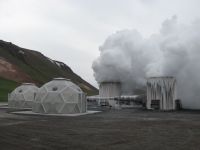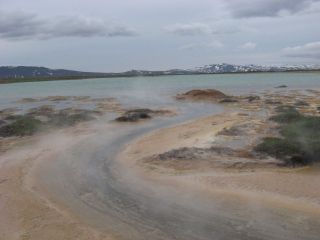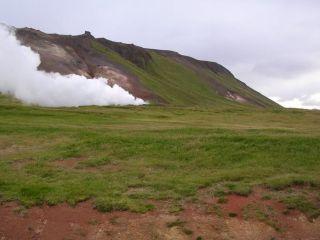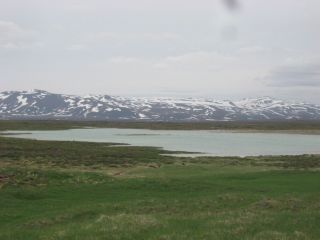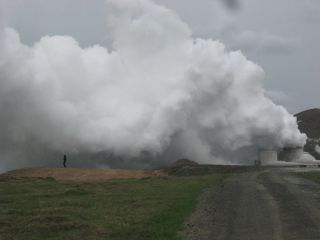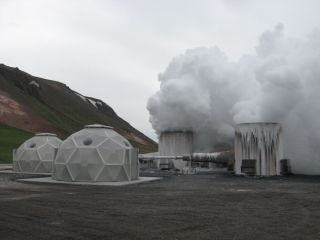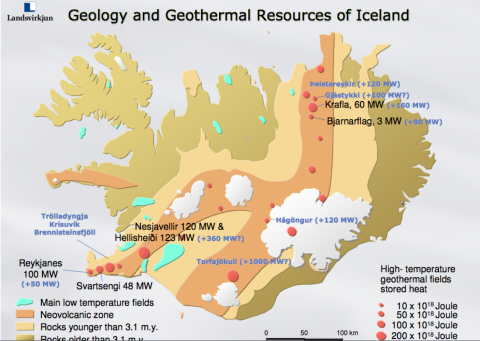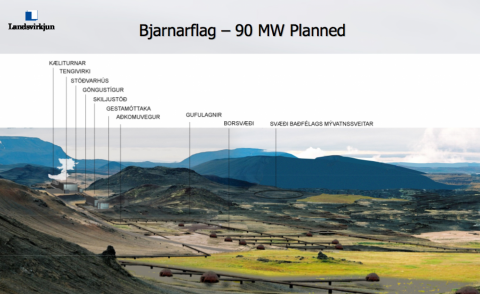A recent exploration of the geothermal drilling sites in the North of Iceland by some members of Saving Iceland, uncovered shocking evidence of pollution and ecological damage at the Þeistareykir geothermal area near to Husavík.
Þeistareykir is one of three sites in the North currently being test drilled and researched to power the upcoming 250,000 tonne ALCOA smelter proposed at Bakki in Husavík. The area is about an hours drive from the main road down a rough track, and is located about half way between Husavík and Krafla (the biggest geothermal zone in the North, where extensive expansion to the current power plant is also taking place).
Þeistareykir was first drilled in August 2007 and now contains three pods which belch huge quantities of Sulphurous steam and make a sound similar to a jet taking off, which shakes the surrounding ground. Below the two most active pods, and in front of a small sleeping hut for tourists is a huge blue lagoon, the source of which can be easily traced to a steaming outlet pipe from the drill pods. The pool has no outlet stream to drain the water away, and therefore must be continually expanding as more effluent water runs into it. This new lake is not shown on maps, and comparisons to photos taken in 2004 confirm that this is an utterly new phenomenon.
Geothermal outlet water contains a number of toxic elements including Arsenic (usually at 0.5-4.6 ppm, well over the WHO standard of 0.01 ppm) and Sulphur, which are very damaging to vegetation and animal life. Test drilling for geothermal power does not require an Environmental Impact Assessment (EIA) in Iceland, as it is supposed to have very limited effects on the environment, and effluent water is supposed to be pumped back into the boreholes. Instead hot, toxic water is being pumped directly onto grassland in an area which is designated a ‘national memorial'(1). This careless act of pollution shows total disregard for this rare and sensitive environment, and a total lack of respect for the EIA procedure which is supposed to protect against unaccounted for environmental disasters, and hold the companies accountable for their behaviour.
The North Iceland environmental group SUNN demanded an EIA at Þeistareykir last July before drilling began, but as yet have been denied it. The drilling company (Þeistareykir ehf- a conglomeration of the Husavík energy company (Orkuveita Husavíkur), North Icelandic Energy (Norðurorka) and the National Power Company (Landsvirkjun)), will only need an EIA for the construction of the power plant at Þeistareykir. It has been common practice that once an area like this has already been ruined, the next stage (the power plant and associated buildings and roads) is pushed through, as the EIA concludes that due to existing damage the additional construction will not be ruining anything too valuable.
Geothermal drilling in the North of Iceland is required to power the upcoming Husavik ALCOA Aluminium smelter which will start at 250,000 tonnes but is already expected to expand to 500,000 tonnes in the first few years after construction. ALCOA and the Icelandic energy companies have joined together to fund the ‘Icelandic Deep Drilling Project’, a new technology that they hope will vastly increase the amount of energy available for the power guzzling smelter. Despite this, they currently only have 25% of the energy they require for the initial capacity, and will require at least 15 more boreholes at Krafla aswell as two rivers at Skagafjörður and Skjálandafljot in Husavík if they are to expand to full capacity as planned. The new boreholes at Þeistareykir are expected to produce up to 150 MW, while drilling at Krafla may expand the current 60MW to 220MW. In addition 100 MW is hoped for at Gjástykki, and 90MW at Bjarnarflag. (see Landsvirkjun’s own map of geothermal power options, and projection of the Bjarnaflag power station below).
If the history of ALCOA smelter construction in Iceland is anything to go by, the energy companies and this Aluminium giant will cut every corner they can to maximise profit and minimise information about the environmental negatives of this mega project. There have already been a number of pro-smelter meetings in Husavík, thanks to the brainwashing and bribery of ALCOA, and their billion dollar PR machine, which cleverly denies and covers up negative scientific reports and environmental costs such as this. For this reason it is essential that we hold these rogue companies accountable for their actions and stop them from continuing to destroy Iceland’s most valuable resource (its stunning and rare nature) without permission or public knowledge. Iceland prides itself on its green image, yet its environmental laws allow for irreversible damage to nature without even an assessment of the possible impact on rare and protected areas.
The beautiful geothermal area of Gjástykki is now the only significant geothermal area in the North which can still be saved. This unspoilt area is filled with stunning caves and crevices and must be protected before a similar environmental tragedy occurs here, out of the public eye. Geothermal areas may be fairly common in Iceland but they are incredibly rare on a world scale. Iceland has a duty to protect these scientifically fascinating areas before they are irreversibly destroyed.
(1) Areas in Þeistareykir and Öxarfjörður are registered national memorials. Morgunblaðið, 15th Nov 1998, ‘Free Enterprise is the Condition for the Most Economical Power Plants’ .
See also these maps:
